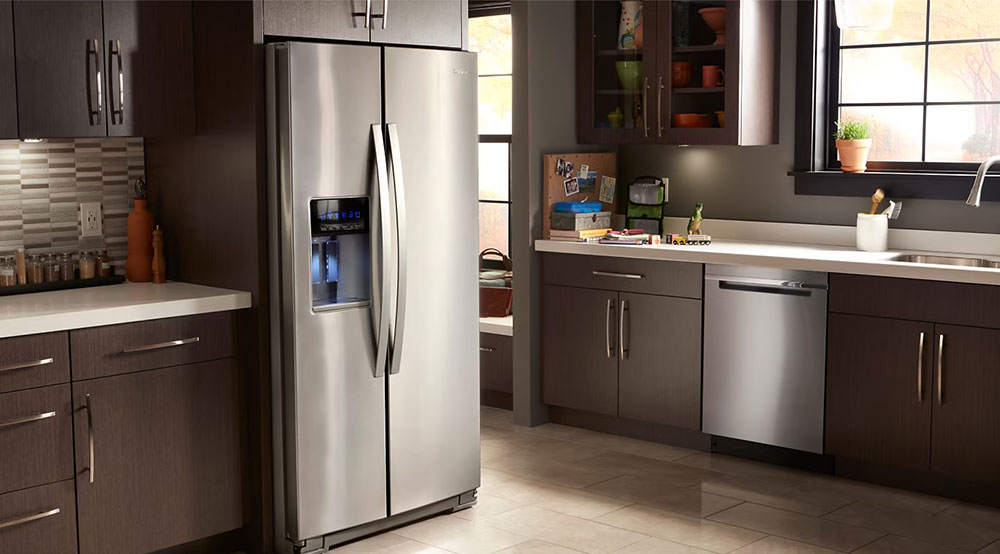Moving a refrigerator involves meticulous planning and careful handling, given its considerable size, substantial weight, and sensitive components. The task extends beyond mere transportation of an appliance; it encompasses safeguarding the integrity and lifespan of a vital household item.This time, we detail the necessary steps for safely preparing and moving a refrigerator, underscoring SQ Moving Company‘s exceptional proficiency in offering top-tier moving services.
Essential Steps to Prepare Your Refrigerator for Moving
Cleaning and Defrosting
The first step in moving a refrigerator is to clean and defrost it. This involves removing all perishables and unplugging the appliance at least 24 hours before the move. Allow sufficient time for the ice to melt and clean the interior thoroughly to prevent mold growth and odors. A clean and dry refrigerator is easier and safer to transport.

In the process of moving a refrigerator, cleaning and defrosting are critical tasks that require attention to detail. Removing perishables and unplugging the appliance well in advance prevents leakages and reduces the risk of slip hazards during the move. It’s essential to note that defrosting a refrigerator can take several hours, and rushing this step could lead to water damage in your home or the moving vehicle. Statistics suggest that a thorough defrosting and cleaning can prevent up to 70% of potential moving day accidents related to refrigerator leaks. Ensuring that the refrigerator is completely dry and free of food residue not only makes transportation safer but also preserves the cleanliness and functionality of the appliance in its new setting.
Securing Internal Components
Before moving a refrigerator, it’s important to secure its internal components. Remove or tightly secure shelves and drawers to prevent them from moving during transit. This step reduces the risk of internal damage and ensures that your refrigerator remains functional after the move.
This precaution is especially crucial for long-distance moves, where the risk of internal shifting is higher. Industry experts estimate that proper securing of internal components can reduce the chances of in-transit damage by up to 50%. Using materials such as foam padding or bubble wrap to stabilize loose parts can be an effective method. It’s not only about preventing breakage; this step also maintains the alignment and functionality of the cooling system, ensuring the appliance resumes normal operation promptly after installation in its new location.
Choosing the Right Equipment and Techniques
Equipment Checklist
Moving a refrigerator safely requires the right equipment. A sturdy dolly, moving straps, and furniture sliders are essential to ensure a smooth move. These tools help in safely maneuvering the refrigerator through doorways and loading it onto the moving truck. Remember, safety is paramount, and using the appropriate equipment is non-negotiable.
Moving a Refrigerator: Proper Moving Techniques

Source: Whirlpool
When you are about moving a refrigerator, proper techniques are necessary. Always keep the refrigerator upright to avoid damage to the cooling mechanisms. Use the dolly to transport the refrigerator and secure it firmly during the move. Avoid sharp tilts and ensure that the refrigerator is adequately protected with moving blankets.
Relying on Professional Movers: SQ Moving Company
For those seeking expert assistance, SQ Moving Company offers specialized services in moving large appliances like refrigerators. With their experienced team and the right tools, they ensure that your refrigerator is moved safely and efficiently. Trusting professionals like SQ Moving Company can save you from potential injuries and appliance damages.
The Benefits of Professional Movers
Hiring a professional moving company like SQ Moving Company for moving a refrigerator provides peace of mind. Their team is trained to handle bulky items and navigate challenging spaces. Moreover, they bring the necessary equipment to secure and transport your refrigerator without incident. This expertise is particularly valuable in complex moving situations.
These professionals are not only skilled in maneuvering bulky items through tight spaces but also in implementing methods to minimize the risk of damage. Research suggests that using professional movers can reduce the likelihood of appliance damage by up to 80%, as compared to self-moving. Furthermore, their experience in assessing and managing potential risks ensures a smooth, efficient moving process.
Post-Move: Setting Up Your Refrigerator
Waiting Before Plugging In
Once your refrigerator is in its new location, it’s important to wait a few hours before plugging it in. This allows the fluids and gases in the cooling system to settle, ensuring the appliance functions correctly. Patience during this phase is key to the longevity of your refrigerator.

Experts recommend a waiting period of at least 3 to 4 hours, though some suggest up to 24 hours for refrigerators that have been transported on their side. This waiting period allows the oil and refrigerant, which may have been agitated during the move, to return to their designated positions and stabilize.
This precautionary step is crucial as it directly influences the operational efficiency and lifespan of the refrigerator’s compressor. Studies have shown that immediate usage after transportation can lead to a 30% higher risk of compressor failure. Thus, a bit of patience after moving a refrigerator can significantly contribute to its optimal performance and durability in your new home.
Final Checks and Adjustments
After the waiting period, plug in the refrigerator and monitor its performance. Check the temperature settings and make sure it’s cooling efficiently. This is also a good time to reinsert and adjust the internal components like shelves and drawers.
Ensuring a Smooth Move
Moving a refrigerator can be a complex task, but with the right preparation, equipment, and techniques, it can be done safely and effectively. Whether you choose to do it yourself or rely on the expertise of a professional moving company like SQ Moving Company, following these guidelines will help ensure that your refrigerator arrives at its new home in perfect condition. Remember, a successful move is all about planning, patience, and precision.











